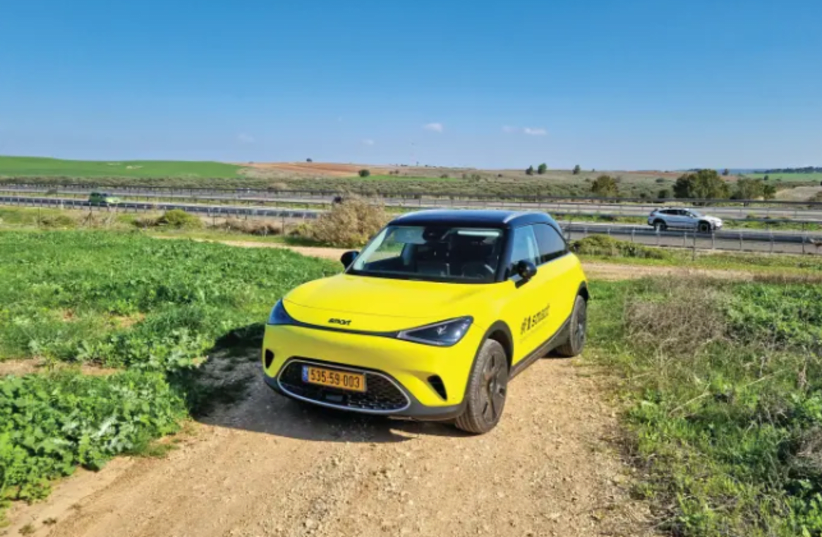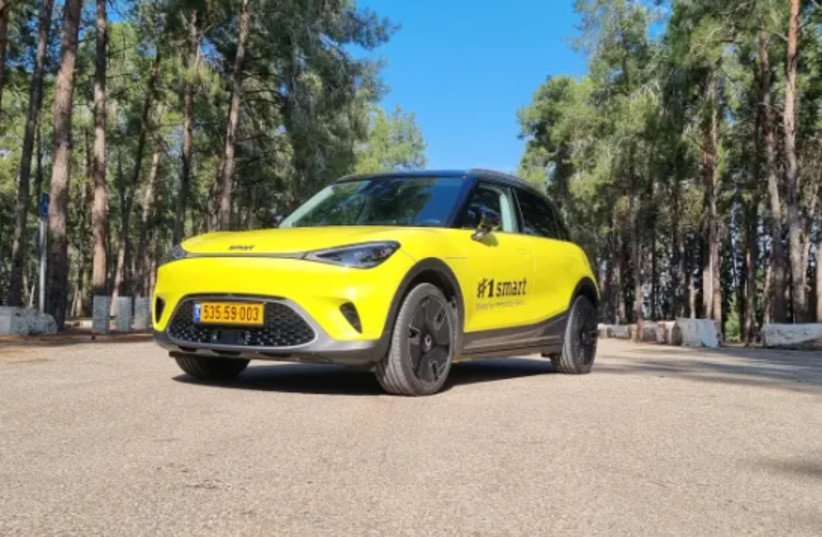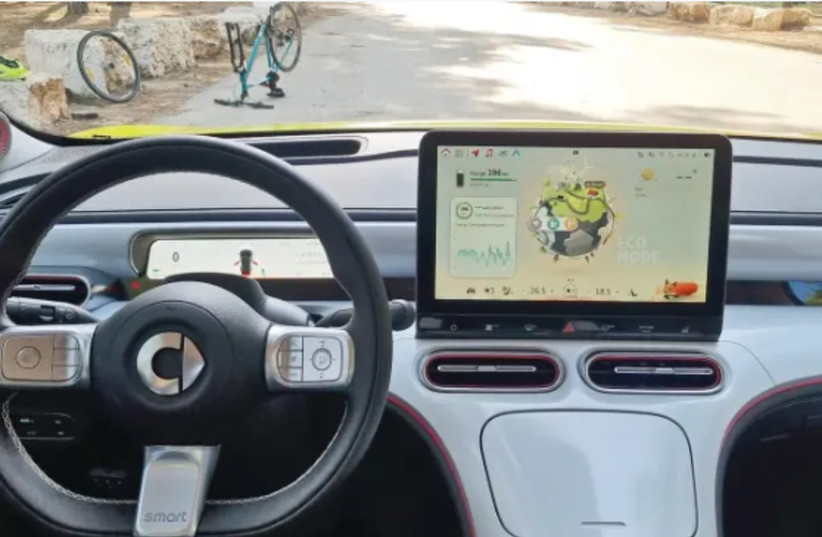On the Smart's interface, there is a Trip button that, when pressed, immediately switches the display on the compact dashboard to the navigation computer, allowing the driver to see the accumulated, momentary, and remaining energy consumption. In most electric vehicles, these details are hidden among various screens, requiring repeated touches on the main multimedia screen, which poses a dangerous diversion from the road. But not in the Smart.
Some may consider this a minor detail in a new car, but I enjoy using the navigation computer while driving and monitoring fuel consumption, both in gasoline cars and in cars I am not currently testing. And this detail proves that the Smart 1 was planned by people who have already built several cars in their lifetime, not just smartphones, as many electric vehicles seem to convey. And this detail gives optimism towards driving itself.
Okay, we can go back to the beginning. Smart was born in the early 1990s as a venture to produce a small urban car, which sprouted from the Swiss watchmaker Swatch, connected with Volkswagen, and finally landed in the hands of Mercedes. It was supposed to be a brilliant urban solution that solves parking problems. Yes, only two seats, but in most of our trips, we don't need more than that, and it allows for the production of a compact car that can be parked width-wise and utilize parking spaces that no other car could.
In 1998, the first generation was launched, and since then the brand has undergone several changes, such as the truly innovative start-up motor. Initially, Mercedes expanded it to a small and enjoyable roadster version, changed its name to the regular model to Smart Fortwo ("for two") and added a 5-door model, Forfour ("for four"). But the project still lost money, so it was restarted, for another generation, in collaboration with Renault - in 2014, the Port two-door model was introduced, slightly larger than before and still with rear-wheel drive, alongside the compact, unique four-door Fortwo, from which the French derived the third generation of the Twingo.
When this attempt also failed economically, Mercedes sold 50% of the rights to the Chinese Jili, who took responsibility for producing a new series of cars. It is now a brand of electric crossovers and SUVs only, marketed worldwide by Mercedes and serviced at its centers, with the assurance that it is a young luxury brand.
Meanwhile, the smaller, more compact Smart 1 and 3 models were launched, followed later in the year by the 5 model. Currently, the Smart 1, with its shortened name, is available in the country, sharing a platform with the EX30 Volvo, which will arrive in February, and the Zikr X, which will be launched here next week.
Time to drive.
Design: The sloping roof, with its slant at the rear, is intended to evoke the original small Smart. The new snout, however, gives it the high stance of a SUV. All the lines, like the handle for opening, do not give a sense of being a Chinese car, but rather much more German.
Compact dimensions: 4.27 meters in length, but also 1.82 meters in width and 1.63 meters in height, shorter but wider than the Hyundai Kona. The original SmarT EQ was dwarfed compared to the new one: 2.54 meters in length, 1.51 meters in width, 1.50 meters in height, and a wheelbase of 1.81 meters. In fact, the SmarT EQ is shorter than the wheelbase of the new SmarT Limo. The driving environment is new, modern, and futuristic. The seating position is high, and there is a 12.8-inch multimedia screen that emerges from the dashboard, as well as a narrow 9.2-inch screen that serves as an instrument panel. There are compartments with covers that elegantly close for the mobile phone, including charging, and other gadgets. The material quality is generally good, but not Mercedes-like, with extensive use of recycled materials.
The seating position is high, and the human engineering is generally good, except that, as usual nowadays, there is an excess of screens and information on the multimedia screen. At least its graphics are original and smile-inducing. Although it is a small luxury car, it is very spacious even for rear passengers. Mercedes claims that it is as spacious as the rear seat of the E-Class sedan, a claim that I hope is an exaggeration for this Mercedes, which is a compact car. However, there is certainly enough space for knees and the head of an adult. Three adults can sit here comfortably. There is air conditioning and a pair of USB sockets.
The rear cargo compartment, with a capacity of 411 liters, is relatively large, with small storage compartments on the side and with tie-down hooks and hangers. However, it is relatively high, which requires some muscle effort when lifting loads. Below it, there is a compartment for the charging cable. There is also a small front cargo compartment under the non-engine cover, but it mainly contains the inflation kit that replaces the spare tire.
Equipment: The Pro+ basic trim level (at 175,000 shekels) comes with 19-inch lightweight rims, a 12.8-inch multimedia screen that includes Android Auto and Apple CarPlay integration, a 9.2-inch digital instrument cluster, a panoramic sunroof, a power-adjustable driver's seat, vegan leather upholstery, climate control with rear seat outlets, and reverse and 360-degree cameras.
The Premium trim level (at 190,000 shekels) adds matrix LED headlights, an efficient head-up display for the driver, a wireless charging pad for mobile devices, and a Beats stereo system with 13 speakers. There is also a Launch Edition (at 195,000 shekels), which includes gold elements. Its production is limited: only 1,000 units in total, 50 of which arrived in the country, all numbered. And there is also the Brabus trim level (at 210,000 shekels), which includes not only performance upgrades with dual-motor drive and 428 horsepower but also a sportier design, suspension tuning accordingly, and even artificial engine noise. Hopefully, we will meet it in the future.
Safety: The Smart 1 received a maximum 5-star rating in the European crash test in 2022. All trim levels come with autonomous emergency braking (forward and backward in all levels except the base, which only has it for parking speeds), adaptive cruise control, lane departure correction, dead-spot warning and prevention, door opening warning when a vehicle passes by, driver alert control, automatic high beam, and parking assist.
Engine and Performance: The regular Smart has rear-wheel drive and 272 horsepower, a combination that until recently could only be found in a sports car, but in the electric age has become quite standard. The performance is excellent, but there's no punch in the back when switching from economical driving mode to sport and putting the gas pedal to the floor, perhaps because this car is small but weighs a healthy 1800 kg, like two Kia Picantos. There's no problem overtaking almost anywhere it's allowed, and there's an efficient E-pedal mode for those who want to take advantage of the regenerative charging ability and drive the car with minimal use of the brake pedal. In this mode, the car automatically switches to regenerative braking as soon as the driver lifts the foot off the gas, although with a slight delay.
Range and Charging: The Smart comes to the country with a 66 kWh battery and an official range of 420-440 km. During the test days, it showed an average consumption of 20.1 kWh for over 500 km, but the on-board computer reported that the extensive use of the E-pedal led to a charging of 33 kWh from slowing down, which actually reduced the average consumption to 13.9 kWh. Overall, the 440 km figure is definitely realistic.
The Smart 1 offers a maximum fast charging power of 150 kilowatts, and besides the base model, it is capable of charging at a rate of 22 kilowatts in slow charging, double and more than the norm. In practice, in a position with such power, it achieves a rate of no more than 19 kilowatts, but it can still complete charging from 20% to 80% in just over three hours.
Behavior and comfort: Despite its rear-wheel drive, the Smartrt is not a sports car. It is a bit soft in turns, there is almost no feedback through the steering, and although it can travel fast and very safely in corners, it is not designed for enjoyment. On the other hand, it is also less comfortable than expected, primarily due to the impractical and pleasing 19-inch wheels.
Bottom line: The Smart 1 is what its creators hoped it would be: a charismatic and different crossover from the electric cars starting to fill the roads. It is also relatively inexpensive compared to cars on display in Mercedes showrooms, with a base price of 175,000 shekels for the base Pro+ and 190,000 shekels for the test car, although in Europe its price is closer to that of less credited electric cars like the BYD E3. The prices will also increase in the next shipment, which will be subject to the new purchase tax on electric cars, 35% instead of 20%. At least the services are once every two years or every 30,000 kilometers.
Beyond the design, both externally and internally, the Smart 1 is a well-crafted product, not just another generic electric car that added a Chinese start-up sound and wants to be Tesla. There is an interesting brand positioning here for those looking for a family electric car with character. Hopefully, the Chinese and the Germans have not given up on finding a successor to the original and small Smartrt. Electric power is indeed an efficient solution to the pollution problem in the city, but parking problems are not going anywhere.


